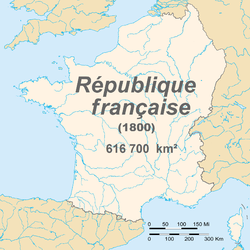Natural borders of France

The natural borders of France (French: Frontières naturelles de la France) were a nationalist model of French state-building developed during the French Revolution that called for the expansion of France's borders to prominent natural boundaries.[1] These boundaries correspond to the Rhine, the Alps, the Mediterranean Sea, the Pyrenees and the Atlantic Ocean.
According to University of California, Berkeley, historian Peter Sahlins, "as a model of French identity, it formed part of a constitutive myth of the state."[1]
Theory
The first mention of the natural borders appeared in 1642 in an apocryphal statement by Cardinal Richelieu.[2][3]
However, it was not until 1786 that the idea started to develop again. The
This notion was influential among the French revolutionaries after 1790, notably among theIn his seminal lecture What Is a Nation?, wherein he criticizes primordialist accounts of the nation, French historian Ernest Renan argues against the notion that France's borders are natural. He wrote, "The frontiers of France in 1789 had nothing natural or necessary about them."[7]
The theory of France's natural borders was commonplace in French textbooks until the mid-20th century.[1] According to University of California, Berkeley, historian Peter Sahlins, "most historians of France today dismiss the "doctrine" of natural frontiers as too teleological a reading of France's history."[1] According to Sahlins, "as a model of French identity, it formed part of a constitutive myth of the state."[1]
Application
In the Alps
The
In Rhineland
Danton's rhetoric was spread throughout the occupied territories by the representatives of the Convention and the local supporters of the French,[8] in order to prepare and justify the annexation of the territories. Even so, the French were beaten at the Battle of Neerwinden on March 18, 1793, and were forced to leave Belgium. The decisive French victory at the Battle of Fleurus in July 1794 and the founding of the Batavian Republic in January 1795 confirmed the French occupation of Belgium. Prussia started the negotiations that finished with the first treaty of Basel, signed April 5, 1795, by which Prussia ceded to France its territories on the left bank of the Rhine. The
In Belgium
After the victory at Fleurus, long debates took place at the Convention to decide the fate of the
The formation of the Hexagon
Under the Consulate and the First French Empire, Napoleon expanded France to its theoretical natural borders through his conquests, mainly with the goal of controlling the coasts. In fact, the war against the United Kingdom rested partly on the ban on all commerce with Great Britain. In 1812, France had 130 departments (134 including the four departments in Catalonia, which were only partially integrated). France's territory was stretched beyond the Rhine by the annexation of the Kingdom of Holland (1810), and the north coast of Germany to Lübeck (1811), beyond the Pyrenees by the annexation of part of Catalonia (1812), and beyond the Alps by the annexation of parts of Italy between 1801 and 1805. After the first abdication of Napoleon on April 6, 1814, France lost, by the Treaty of Paris, all its territories conquered after 1792. France only kept a small part of Savoy. After Waterloo, by the second Treaty of Paris in 1815, France was taken back to its 1790 borders and therefore lost Savoy. Savoy and Nice were definitively annexed by France in 1860 by the Treaty of Turin.
The debate over France's borders continued throughout the nineteenth century.
See also
- French nationalism
- Gallia Belgica
- Lebensraum
- Irredentism
- Territorial evolution of France
- 130 departments of the First French Empire
References
- ^ JSTOR 2162692.
- ^ Pernot, François (2001). "Janvier 1595 : Henri IV veut couper le Camino Español en Franche-Comté". Revue historique des armées (in French) (222): 13–24. Archived from the original on February 12, 2009.
- ISSN 0004-5608.
- ^ Smets 1998, p. 676.
- ^ Smets 1998, p. 677.
- ^ "Les limites de la France sont marquées par la nature, nous les atteindrons des quatre coins de l'horizon, du côté du Rhin, du côté de l'Océan, du côté des Pyrénées, du côté des Alpes. Là doivent finir les bornes de notre République."
- ISBN 9780231547147.
- ^ Smets 1998, pp. 680–681.
- ^ Smets 1998, pp. 689–691.
Bibliography
- Smets, Josef (1998). "Le Rhin, frontière naturelle de la France" [The Rhine, natural border of France]. Annales historiques de la Révolution française. 314 (314): 675–698. . (in French)
- Sébastien Dubois, "La conquête de la Belgique et la théorie des frontières naturelles de la France (XVIIe ‑ XIXe siècle)," in Laurence Van Ypersele (dir.), Imaginaires de guerre. L'histoire entre mythe et réalité, proceedings at ISBN 2-87209-697-3, pp. 171–200
- Denis Richet, "Frontières naturelles", in François Furet (dir.) and Mona Ozouf (dir.), Dictionnaire critique de la Révolution française, Paris, 1988, 1992, 2007
- (in French) Jean Tulard, Jean-François Fayard and Alfred Fierro, Histoire et dictionnaire de la Révolution française. 1789–1799, Robert Laffont, Bouquins collection, Paris, 1987 (ISBN 270282076X)
